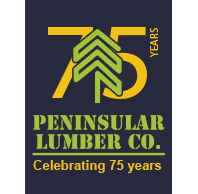A well-designed deck can transform your outdoor space into a functional and inviting extension of your home. Whether you’re looking to create a space for relaxation, entertaining, or family activities, building a deck offers countless possibilities. However, designing the perfect deck requires careful planning to ensure it meets your aesthetic, functional, and budgetary needs.
At Peninsular Lumber, we specialize in providing high-quality materials for building custom decks that are tailored to your preferences. In this blog, we’ll explore essential design considerations for your deck, from layout and style to functionality and materials.
1. Consider the Purpose of Your Deck
Before jumping into the design process, it’s important to consider the primary function of your deck. What activities do you plan to use your deck for? Your deck’s layout and features should align with its intended use.
Common Deck Uses:
- Outdoor Dining and Entertaining: If you plan to host gatherings, barbecues, or dinners outdoors, make sure to incorporate ample space for seating, a dining table, and cooking equipment like a grill or outdoor kitchen.
- Relaxation and Quiet Retreat: If relaxation is your priority, consider a space for comfortable lounge chairs, a hammock, or a small fire pit area. A shaded or semi-private area will also enhance the peaceful atmosphere.
- Family Play and Activities: For families with children or pets, consider adding an open area for play, or a section with built-in benches, planters, and safe, durable flooring.
Tip: The more specific you are about your deck’s purpose, the better you can design it to meet your needs.
2. Choose the Right Deck Layout
Once you’ve determined the primary use of your deck, the next step is designing the layout. The layout will dictate how functional and comfortable your deck is, so it’s important to plan thoughtfully.
Key Considerations for Deck Layout:
- Shape: Decks can be designed in a variety of shapes to suit your outdoor space, including rectangular, square, circular, or even more organic, freeform designs. Choose a shape that complements your home’s architecture and the surrounding landscape.
- Size: Make sure the size of the deck is proportional to your outdoor space. A small yard may benefit from a compact, multi-level deck, while a larger space might accommodate a larger, sprawling design.
- Flow and Connectivity: Consider how the deck will connect to your home and other outdoor areas, such as gardens, patios, or walkways. Your deck should feel like a seamless extension of your living space.
- Zoning: If you’re designing a large deck, think about dividing it into zones based on function. For example, you can have one area for dining, another for lounging, and a separate zone for a fire pit or bar.
Tip: Make sure to allow for proper traffic flow, ensuring easy movement between different zones of the deck.
3. Choose a Deck Style That Matches Your Home
The style of your deck should complement your home’s architecture and overall aesthetic. Whether you prefer a traditional, rustic, or modern look, your deck design should blend harmoniously with your house.
Popular Deck Styles:
- Traditional: A classic, symmetrical design with railing details and consistent spacing is perfect for a more traditional home. Wood finishes like cedar or redwood enhance the natural beauty of a traditional deck.
- Modern/Contemporary: For a sleek, clean look, consider using materials like composite decking, which offer a polished, low-maintenance finish. Modern decks often feature straight lines, minimalistic design, and integrated lighting.
- Rustic or Cottage-Style: If your home has a rustic or cottage aesthetic, consider using reclaimed wood or natural, unfinished lumber for a more organic look. Adding decorative touches like a pergola or trellis can further enhance the rustic charm.
- Coastal or Beach-Inspired: For homes near water, a coastal deck design might feature light-colored woods, aluminum railings, and nautical-themed accents.
Tip: Consider the materials and finishes that will help achieve your desired style while also being durable enough to withstand outdoor elements.
4. Select the Right Materials for Durability and Aesthetics
When building a deck, selecting the right materials is crucial for both the look and longevity of the structure. The right materials can enhance your deck’s style while ensuring it stands the test of time.
Common Decking Materials:
- Pressure-Treated Lumber: This affordable, classic option is treated to resist rot and insect damage. It’s great for budget-conscious projects but requires regular maintenance, such as staining and sealing.
- Cedar or Redwood: These natural woods are beautiful and resistant to insects and decay. However, they require more maintenance than synthetic options, such as staining or sealing every few years.
- Composite Decking: Made from a blend of wood fibers and plastic, composite decking is low-maintenance, durable, and available in a variety of colors and textures. It’s ideal for homeowners looking for a long-lasting, virtually maintenance-free deck.
- PVC Decking: Made entirely from plastic, PVC decking is highly resistant to moisture and stains. It’s available in a variety of colors and offers a sleek, modern look with minimal upkeep.
- Tropical Hardwoods: For a luxurious, exotic look, consider tropical hardwoods like ipe, teak, or mahogany. These woods are incredibly durable and offer a stunning appearance but come at a higher price point.
Tip: Choose materials that align with your budget and desired maintenance level. If you prefer low-maintenance options, composite or PVC decking is a great choice.
5. Incorporate Functional Features
To enhance the usability and enjoyment of your deck, consider adding functional features that meet your specific needs and add extra value to your outdoor space.
Popular Deck Features:
- Built-in Seating: Add benches or integrated seating areas to maximize space and provide comfortable options for guests.
- Lighting: Incorporating outdoor lighting, such as string lights, deck post lights, or recessed lighting, can enhance the ambiance and safety of your deck, making it usable at night.
- Railing and Privacy: Choose railing designs that not only enhance the aesthetics of your deck but also provide safety. If you’re looking for added privacy, consider adding privacy screens, lattice panels, or hedges.
- Shade and Shelter: For decks exposed to the sun, adding a pergola, canopy, or retractable awning can provide much-needed shade, allowing you to enjoy your deck in comfort throughout the day.
Tip: Think about your deck as an extension of your living space and incorporate elements that enhance both comfort and functionality, such as comfortable seating or shade.
Visit Peninsular Lumber in Tampa for Your Custom Door Project
Designing a deck that fits your outdoor space requires thoughtful planning, but the result is worth the effort. Whether you’re creating a space to entertain, relax, or enjoy family activities, a well-designed deck can add both beauty and functionality to your home. At Peninsular Lumber, we provide the high-quality materials you need to bring your deck vision to life. From pressure-treated wood to composite decking, we have everything you need to build a deck that fits your style and budget.
Visit Peninsular Lumber for all the materials and advice you need to bring your project to life. Our team is ready to help you protect your investment while adding timeless beauty to your home. Stop by today and let’s get started on your next project!
Visit us at Peninsular Lumber in Tampa for Your Next Project



